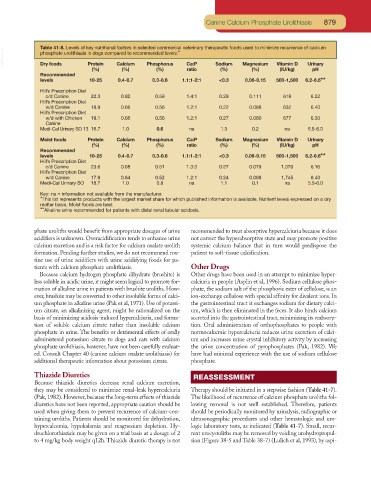Page 848 - Small Animal Clinical Nutrition 5th Edition
P. 848
Canine Calcium Phosphate Urolithiasis 879
Table 41-8. Levels of key nutritional factors in selected commercial veterinary therapeutic foods used to minimize recurrence of calcium
VetBooks.ir phosphate urolithiasis in dogs compared to recommended levels.*
Protein
Dry foods
(%)
(%) Calcium Phosphorus Ca:P Sodium Magnesium Vitamin D Urinary
(%)
(IU/kg)
pH
(%)
ratio
(%)
Recommended
levels 10-25 0.4-0.7 0.3-0.6 1.1:1-2:1 <0.3 0.06-0.15 500-1,500 6.2-6.6**
Hill’s Prescription Diet
c/d Canine 22.3 0.82 0.59 1.4:1 0.28 0.111 618 6.22
Hill’s Prescription Diet
w/d Canine 18.9 0.66 0.56 1.2:1 0.22 0.088 632 6.40
Hill’s Prescription Diet
w/d with Chicken 19.1 0.66 0.56 1.2:1 0.27 0.080 677 6.30
Canine
Medi-Cal Urinary SO 13 16.7 1.0 0.6 na 1.3 0.2 na 5.5-6.0
Moist foods Protein Calcium Phosphorus Ca:P Sodium Magnesium Vitamin D Urinary
(%) (%) (%) ratio (%) (%) (IU/kg) pH
Recommended
levels 10-25 0.4-0.7 0.3-0.6 1.1:1-2:1 <0.3 0.06-0.15 500-1,500 6.2-6.6**
Hill’s Prescription Diet
c/d Canine 23.6 0.68 0.51 1.3:3 0.27 0.079 1,370 6.16
Hill’s Prescription Diet
w/d Canine 17.9 0.64 0.52 1.2:1 0.24 0.088 1,745 6.40
Medi-Cal Urinary SO 18.7 1.0 0.8 na 1.1 0.1 na 5.5-6.0
Key: na = information not available from the manufacturer.
*This list represents products with the largest market share for which published information is available. Nutrient levels expressed on a dry
matter basis. Moist foods are best.
**Alkaline urine recommended for patients with distal renal tubular acidosis.
phate uroliths would benefit from appropriate dosages of urine recommended to treat absorptive hypercalciuria because it does
acidifiers is unknown. Overacidification tends to enhance urine not correct the hyperabsorptive state and may promote positive
calcium excretion and is a risk factor for calcium oxalate urolith systemic calcium balance that in turn would predispose the
formation. Pending further studies, we do not recommend rou- patient to soft-tissue calcification.
tine use of urine acidifiers with urine acidifying foods for pa-
tients with calcium phosphate urolithiasis. Other Drugs
Because calcium hydrogen phosphate dihydrate (brushite) is Other drugs have been used in an attempt to minimize hyper-
less soluble in acidic urine, it might seem logical to promote for- calciuria in people (Asplin et al, 1996). Sodium cellulose phos-
mation of alkaline urine in patients with brushite uroliths. How- phate, the sodium salt of the phosphoric ester of cellulose, is an
ever, brushite may be converted to other insoluble forms of calci- ion-exchange cellulose with special affinity for divalent ions. In
um phosphate in alkaline urine (Pak et al, 1971). Use of potassi- the gastrointestinal tract it exchanges sodium for dietary calci-
um citrate, an alkalinizing agent, might be rationalized on the um, which is then eliminated in the feces. It also binds calcium
basis of minimizing acidosis-induced hypercalciuria, and forma- secreted into the gastrointestinal tract, minimizing its reabsorp-
tion of soluble calcium citrate rather than insoluble calcium tion. Oral administration of orthophosphates to people with
phosphate in urine. The benefits or detrimental effects of orally normocalcemic hypercalciuria reduces urine excretion of calci-
administered potassium citrate to dogs and cats with calcium um and increases urine crystal inhibitory activity by increasing
phosphate urolithiasis, however, have not been carefully evaluat- the urine concentration of pyrophosphates (Pak, 1982). We
ed. Consult Chapter 40 (canine calcium oxalate urolithiasis) for have had minimal experience with the use of sodium cellulose
additional therapeutic information about potassium citrate. phosphate.
Thiazide Diuretics REASSESSMENT
Because thiazide diuretics decrease renal calcium excretion,
they may be considered to minimize renal-leak hypercalciuria Therapy should be initiated in a stepwise fashion (Table 41-7).
(Pak, 1982). However, because the long-term effects of thiazide The likelihood of recurrence of calcium phosphate uroliths fol-
diuretics have not been reported, appropriate caution should be lowing removal is not well established. Therefore, patients
used when giving them to prevent recurrence of calcium-con- should be periodically monitored by urinalysis, radiographic or
taining uroliths. Patients should be monitored for dehydration, ultrasonographic procedures and other hematologic and uro-
hypercalcemia, hypokalemia and magnesium depletion. Hy- logic laboratory tests, as indicated (Table 41-7). Small, recur-
drochlorothiazide may be given on a trial basis at a dosage of 2 rent urocystoliths may be removed by voiding urohydropropul-
to 4 mg/kg body weight q12h. Thiazide diuretic therapy is not sion (Figure 38-5 and Table 38-7) (Lulich et al, 1993), by aspi-

